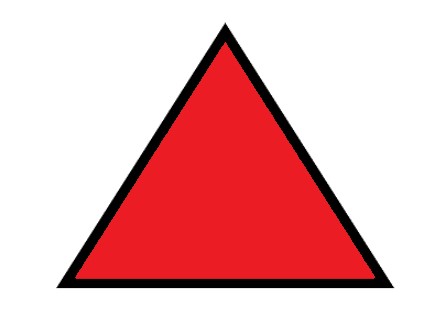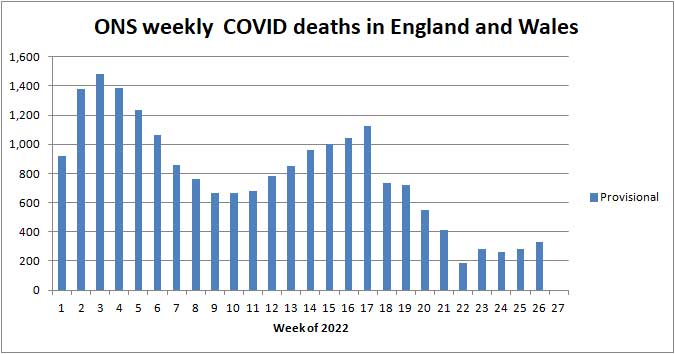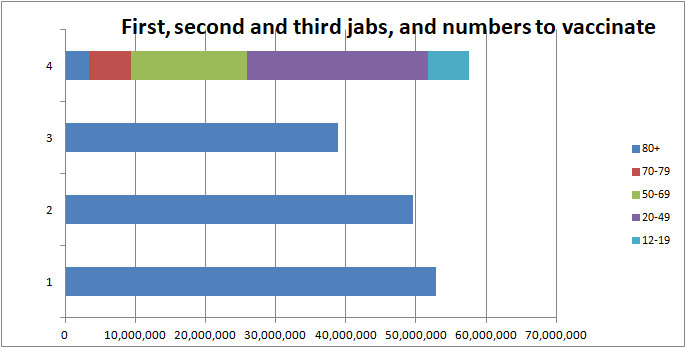
Angus and Rosemary's Miscellany
of Malvern - Other Resources
|
Coronavirus (COVID-19) epidemic weekly update for Malvern SeniorsClick to read our observations on politics and world events 17th July 2022
Remember to get your Spring Booster Polio found in London sewage PreambleFor more than two years we have been keeping an eye on the published government figures and monitoring the media to asses the likely level of risk for Seniors in the Malvern Hills district and providing links to where further information could be found. During the epidemic Public Health England was split into the UK Health Security Agency and Office for Health Improvements and Disparities. However for simplicity, in this blog, we have continued to refer to this as PHE data. Testing has been run down and the public can no longer record the result of Lateral Flow tests so the daily cases reported on the Coronavirus Dashboard greatly underestimate the actual situation, and we have now deleted our section on testing; this can however be found on archived pages. The only remaining sources of data indicating direction of travel are:
Now the epidemic is largely over the numbers are of less importance, but we'll carry on with our blog for a little while longer. This page will continue to be updated each weekend using Friday's data, nominally with Sunday's date. ContentsSummaryThe current wave of COVID-19 caused by the Omicron BA.5 variant, which the Wuhan vaccines rarely stop us catching, is still on the rise. However a slight slowing in the increase of hospital beds occupied by COVID patients suggests the current wave of cases may peak in a week or two. Some good news is that, because of the vaccines, the number of patients on ventilators and deaths is only 4% of that during the worst of the epidemic. As a result of the latest wave of COVID-19 cases, (ONS) weekly deaths in England and Wales can be expected to creep up to between 400 and 800 in the next 4 weeks. What happens will partly depend on the effectiveness of the Spring Boosters, which is an unknown. That might sound scary but it's nothing to worry about. Many of us could catch the COVID-19 BA.5 variant in coming weeks despite being fully vaccinated for the original Wuhan strain. The hard truth is, with regard to catching the disease, the virus has largely evolved to evade both the vaccines, and protection conferred by previous infections. Infections more than 3 months ago (that is from previous variants) are said to provide little protection from catching BA.5. The lucky may either show few symptoms or have a mild fever, sore throat, general aches and pains, and quickly get over it; but many could feel quite poorly and spend a few days in bed, with it taking five to ten days or so to recover. Some of those who have caught COVID report getting easily tired for some weeks afterwards. The precautions to take are now a personal decision; see our advice. The Zoe Health Study suggests as COVID cases continue to increase, you can reduce your risk of infection by wearing a high quality face mask in crowded areas, and avoiding meeting up with friends or family who have cold-like symptoms. To counter vaccine waning and reduce the likelyhood of hospitalisation amongst the most vulnerable, a second COVID-19 booster jab is available to Seniors aged 75+ years known as the Spring Booster. UKHSA recommends everyone eligible should get it, but the Coronavirus Dashboard figures suggests 22% of those aged 75+ in England have yet to step forward, if the vaccine hesitant are taken into account. Some surgeries are offering the Spring Booster, but if not you can get it at the Three Counties Showground vaccination centre (use brown gate). Click for information about Walk-In Clinics Click for information about the Spring Booster Click for Worcestershire Dashboard and associated links The government says there will be an Autumn booster programme for those aged 50+ years; this will be a phased roll out of both COVID and Flu jabs; details are yet to be announced. Note: following Sajid Javid's resignation, Steve Barclay is now Health Secretary. Monkeypox virus alertOutbreaks of Monkeypox have been detected in Europe and the UK. It's a serious and now a notifiable disease. Click below for European Centre for Disease Prevention and Control factsheet:- Factsheet for health professionals on Monkeypox As of 14 July 2022, there were 1,856 confirmed cases in the UK. Of these, 1,778 are in England. This compares to 1,351 cases on 4th July, an increase of about 50 cases per day. The overwhelming majority of cases are said to be in men who have sex with men, and 75% of cases are in London. Click link: Monkeypox cases confirmed in England - latest UKHSA update CNN says as monkeypox cases continue to rise globally, the World Health Organization plans to reassess whether the outbreak constitutes a public health emergency of international concern. The good news for Seniors is that vaccination for Smallpox, which we mostly had as children, should give protection from Monkeypox. PolioPolio is caused by a virus that spreads easily when an infected person coughs or sneezes. It can also be caught from food or water that's been in contact with the stools of someone who has the virus. Polio is a serious illness which can cause disablement and in some cases death. Most Seniors will have been vaccinated against Polio when teenagers. Parents are advised to check that their children's' vaccinations are up to date. Click for government press release - Poliovirus detected in sewage from North and East London How to get vaccinated for COVID-19 (unchanged)Note: by now we expect most Seniors are fully vaccinated and if so you can skip this section. Children aged 5 - 11 years can be offered the vaccine, though only 10% or so have had a first dose in England. This may be because either they have been recently infected or their parents are not keen. All those aged 16+ years can book a booster 3 months after their second dose. Click NHS link - Who can get a coronavirus (COVID-19) vaccine For information about walk-in centres in Worcestershire go to the website: and click the Vaccine Rollout tab at the top of the page. Click for information about vaccination at the Three Counties Showground Otherwise either see the NHS website for walk-in opening times and vaccine availability: Or click this link for more information and to book a vaccination on-line: Book a Coronavirus vaccination - NHS (www.nhs.uk) Or talk to your GP. More about vaccinationsVaccinometerOur bar chart below shows the total number of:
Vaccinometer as of 8th April 2022 People are still coming forward to be vaccinated, but the rate is so slow expect to see little change to this chart during 2022. Vaccination statistics are now of little relevance but can be found on the Vaccination tab of the Coronavirus Dashboard. What's more important is that those who have chosen to be vaccinated get their booster jabs. First booster jabsLast Christmas, all adults were offered a third jab (or booster) to reduce the likelyhood of hospitalisation after being infected by the Omicron variant of COVID-19. Spring booster jabs for SeniorsThose aged 75+ are eligible for a second (Spring) booster which ideally should be 6 months after the first booster. If you have COVID you must wait at least 28 days after infection before getting the jab. You should be contacted by the NHS and invited to book your spring booster when it's due - our invitation came by email followed a week later by a letter. Try to book an appointment around 6 months after your last dose to get the best protection from your Spring Booster (check the date on your vaccination card). New Court Surgery is currently not offering Spring Boosters so you may have to book your booster at a mass vaccination centre, such as the Three Counties Showground, either on-line or by phoning 119. There are also walk-in appointments at the Three Counties Showground (see links in 'how to get vaccinated section' for days and times). Clinics may be suspended during large events. Click to book a Coronavirus vaccination - NHS (www.nhs.uk) Click for NHS England COVID-19 Vaccination statistics Protection against hospitalisationAfter 3 months the Wuhan vaccines seem to give little protection from catching the Omicron variants of COVID-19 but importantly they are said to protect from going on to develop severe illness and admittance to hospital. The UKHSA COVID-19 vaccine surveillance reports indicate the effectiveness of the vaccines against earlier variants - four months or so after a third dose vaccine effectiveness against hospitalisation fell to about 80%, suggesting Seniors had been roughly 5 times less likely to go into hospital compared to an unvaccinated person. Note: there has been insufficient time to gather reliable data on the Spring Booster and the latest variants BA.4 and BA.5, so for example, the protection offered against hospitalisation by BA.5 after a Spring booster is largely unknown. Effectiveness against mortalityAfter a Booster the relative risk of death seems to be reduced by a factor of between 5 and 10. Most people who die are aged 85+ years and most are fully vaccinated; this simply reflects that most of those who die are elderly, most of the elderly population is vaccinated, and the vaccines are not 100% effective. Here is a link to the latest report so you can make up your own mind about the effectiveness of the vaccines. Click for UKHSA COVID-19 vaccine surveillance report Week 27, 7th July 2022 Note: the next report will be in a months time, on 4th August 2022. Vaccinations WorldwideA chart of the worldwide vaccination situation can be found on the Our World in Data website. Click for worldwide statistics Hint: click the country list on the left hand side of the screen to add or remove countries from the chart.
|
| Date published | Prevalence (England) | Ratio of people with COVID |
| 8th July 2022 | 2,154,000 | 1:25 |
| 15th July 2022 | 2,873,600 | 1:19 |
Prevalence of COVID-19 in England estimated by ONS
There is even more COVID in Scotland where 1:16 are infected, but cases appear to be levelling off.
Zoe Health Study
The ZOE Health Study figures are shown in the following table.
| Prevalence (UK) | Estimated new infections per day | |
| Last week | 4,026,483 | 339,265 |
| This week |
4,556,818 | 345,865 |
Prevalence of COVID-19 in UK estimated by Zoe Health Study
According to the more up-to-date Zoe figures, prevalence in the UK has gone up by 13% and daily cases by 2%, which is less than last week suggesting we could be nearing the peak of the current wave.
Numbers testing COVID positive in Worcestershire (PHE)
Note: this section has been deleted due to COVID testing being run down in the UK; figures can still be found on the Worcestershire Coronavirus dashboard - but these greatly underestimate the true number of infections. The direction of travel in Malvern is up.
Click for Worcestershire Coronavirus Dashboard
 Number
of deaths
Number
of deaths
Statistics on COVID deaths are published by Public Health England, The Office of National Statistics, and NHS England. These can't be directly compared as they cover different periods, but together the figures paint a picture of the direction of travel - which is that COVID weekly deaths are rising as a consequence of the new wave of the BA.5 variant sweeping the UK but not, in our view, to a level the public should be concerned about.
PHE figures
The Dashboard chart of COVID (28) deaths, following a positive test, by date of death shows that the 7 day average peaked in England at 240 deaths per day about 10th April; and fell to a minimum of 40 about 10th June. By 4th July deaths had risen to 100 per day and may rise further for another 3 weeks.
This is the most up-to-date indicator and it looks like the death rate will mirror daily hospital admissions. The factor by which deaths increase will partly depend on the effectiveness of the Spring Booster campaign.
Note that some of the deaths reported by PHE could be people who die with COVID but not from it.
Click to view the UK government Coronavirus Dashboard
ONS figures
The Office of National Statistics (ONS) reports registered deaths in England and Wales where COVID-19 is mentioned somewhere on the death certificate. The ONS figures lag the PHE figures by 10 - 14 days and do not include Northern Ireland and Scotland.
Note: the figures include cases where COVID may have been a secondary cause of death.
Click for national ONS data on deaths (Excel spreadsheet)
The ONS figures are broken down by District providing a glimpse of where deaths are occurring. The provisional cumulative total of COVID related deaths in Worcestershire reported by the ONS up to 1st July (week 26 of 2022) is shown below.
Note: the numbers are from summation of rows 9 to 339 of the ONS Death Registrations-Pivot table, which gives the provisional total of deaths reported in any week, which can be distorted by delayed reporting over public holidays.
Deaths by 'date of death' is a more accurate metric but takes longer to be confirmed.
| Districts of Worcs |
Deaths 2020 |
Deaths 2021 |
Deaths 2022 |
Week 26 | Population |
| Bromsgrove | 164 | 142 | 40 | 0 | 98,529 |
| Malvern Hills | 61 | 98 | 49 | 1 | 77,545 |
| Redditch | 108 | 109 | 30 | 2 | 85,317 |
| Worcester | 87 | 134 | 32 | 1 | 103,542 |
| Wychavon | 157 | 154 | 52 | 0 | 126,240 |
| Wyre Forest | 171 | 132 | 42 | 2 | 100,957 |
| TOTAL | 748 | 769 | 245 | 6 | 592,130 |
Provisional cumulative COVID-19 deaths in Worcestershire registered by ONS to 1st July 2022
The Malvern death was categorised 'other communal establishment'. All other Worcestershire deaths this week were in hospital.
In England and Wales 329 COVID-19 related deaths were reported in the week to 1st July, 45 more than the week before and a rise of 16%. Of these 30 were in a care home, 26 at home, 10 in a hospice, 260 in hospital and 3 elsewhere.
So far this year in England and Wales 20,611 people have died with COVID mentioned on their death certificate.

ONS provisional deaths 'by week reported' in England and Wales 2022
Note: the steps in the chart above in weeks 18 and 22 were probably due to delayed reporting over the Easter, Mayday and Jubilee holidays.
The figures on the Coronavirus Dashboard of ONS deaths by date on the death certificate shows ONS England deaths peaked at 160 deaths per day on 8th April, dipped to 25 about 10th June, then increasing to 33 by 17th June (seven day average).
In comparison averaged over recent years 1,700 people die daily from all causes in the UK, so COVID deaths in England now represent about 2% of UK deaths.
Click for ONS Coronavirus (COVID-19) latest insights: Deaths
Deaths reported by ONS are lower than those reported by PHE and there are two reasons for this. First the PHE figures include people who die with COVID but not from it. Second the ONS figures lag behind real time, so when the death rate is rising ONS under reports the true picture.
NHS England figures for Worcestershire
The table below shows the latest COVID deaths in Worcestershire hospitals reported by NHS England on 14th July 2022.
| Worcestershire | Cumulative deaths | Past week |
| Acute hospitals | 1,117 | 14 |
| Care hospitals | 74 | 0 |
| TOTAL | 1,191 | 14 |
Excludes deaths in care homes, deaths at home and deaths in hospices.
There has been an unusually high uptick this week. This may be due to the surge in BA.5 cases and hot weather. However a statistical blip resulting from the change from daily to weekly reporting cannot be ruled out.
Click for NHS COVID-19 total announced deaths
Look for COVID Total announced deaths file, then select tab Deaths by Trust.
Note: NHS say all deaths are recorded against the date of death rather than the date the deaths were announced. As from 1st July 2022 reporting has moved to publication once per week on a Thursday, rather than every weekday.
Risk of COVID-19 death by age band (updated)
NHS England provides an analysis of COVID-19 deaths in hospital in England and Wales by age band. Shown below is a snapshot of 2,898 recent deaths for the period 6th May 2022 to 6th July 2022 when most of these deaths will have been from the Omicron variants.
| Age band | Number of COVID deaths | % of deaths |
| 0 - 19 | 8 | 0.3 |
| 20 - 39 | 25 | 0.9 |
| 40 - 59 | 165 | 5.7 |
| 60 - 79 | 1,010 | 34.9 |
| 80+ | 1,692 | 58.4 |
Relative risk of COVID-19 death by age band May - July 2022
The main point to note is those aged 60+ still account for 93% of deaths despite young people being more likely to catch COVID-19.
The risk profile for Omicron appears to be the same as for Delta. Age is the greatest risk factor.
 Healthcare
numbers
Healthcare
numbers
The UK government Coronavirus Dashboard includes information about healthcare statistics and NHS bed occupancy.
| Hospital COVID cases (England) | Number | Change in last week |
| Patients currently in hospital | 13,741 | +2,276 |
| Patients on ventilation | 275 | +57 |
| Patients admitted daily | 1,861 | +286 |
Headline summary of patients in hospital reported on 13th July 2022
A point to note is that while hospitalisations have been rising sharply the number of patients on ventilators is relatively small.
Note: at the peak of the epidemic about 4,000 patients were on ventilators.
The majority of those admitted to hospital with COVID are said to be aged over 85 years.
Roughly half are being treated for COVID, and the remainder being treated for another condition with COVID.
Bed numbers by region in England
Tabulated figures for COVID bed occupancy in England can be found on the NHS England website and are another indicator of direction of travel:
Click for NHS England COVID-19 Hospital bed Activity statistics
Note: see the latest Daily Admissions and Beds spreadsheets, then look for all COVID beds.
| Region | 8th July 2022 | 15th July 2022 | 15th January 2021 |
| England | 12,283 | 13,975 | 33,362 |
| London | 1,990 | 2,295 | 7,811 |
| Midlands | 2,428 | 2,827 | 5,890 |
Comparison of All beds COVID data for England, London and Midlands
Given the government has declared the COVID emergency over, there are a lot of people occupying hospital beds with COVID. Admittedly these are mostly not Intensive Care beds.
In the last week the number of COVID-19 General and Acute beds rose by 13% in England, 15% in London and 16% in the Midlands.
The rate of increase has slowed a bit suggesting we could be approaching the peak of the current wave of the COVD-19 BA.5 variant.
For comparison, the number of beds occupied during the peak of the epidemic in January 2021 is shown in red in the right hand column of the table.
 Worcestershire
hospital beds
Worcestershire
hospital beds
Between 4 July 2022 and 10 July 2022, 114 patients went into hospital with coronavirus. This shows an increase of just 5% compared to the previous 7 days. There were 116 patients in hospital with coronavirus on 12 July 2022, one less than the week before, of which one was on a ventilator.
Click for Summary of Malvern numbers on the Coronavirus dashboard
This link also reports deaths.
Deaths in Malvern Hills
Between 2 July 2022 and 8 July 2022, there was 1 death within 28 days of a positive coronavirus test.
There could be one or two deaths per week as a result of the BA.5 wave, but nothing to worry about.
Forecast for the week ahead
The number of COVID related deaths in England and Wales (as registered by ONS) may increase by about 400 in Week 27 ending 8th July, to be reported on 19th July.
In the county of Worcestershire, based on 114 new hospital cases last week and assuming the ratio of deaths to be 1:11 of admissions, then about 10 deaths per week can be expected at the beginning of August.
NHS COVID bed occupancy in England reached a minimum of 3,800 in early June and has risen four-fold to 13,975 in the last 6 weeks. If the present wave of cases is peaking we should begin to see bed-occupancy levelling off next week.
Longer term outlook
Theoretically we were supposed to be entering the endemic stage of the disease with a high background level of infection, falling in the summer as more time is spent outdoors, and then rising in the winter.
In reality this would be modulated by new variants against which the vaccines offer increasingly less protection, vaccines waning in effectiveness, booster shots, overseas travel during school holidays, and super-spreader events such as summer music festivals, so it's becoming difficult if not impossible for computer models to predict what will happen.
We are already in early summer and instead of cases falling they are rising. Cases could dip a little in late August and September as we gradually emerge from the BA.5 wave before rising again in October/November when more time is spent indoors with the windows shut.
The Omicron BA.1 variant became predominant in New Year 2022, followed by BA.2 and now BA.5 causing 3 waves of COVID so far, and there may be more to come as the virus evolves.
About 4% of those infected will suffer from symptoms of Long COVID. Long COVID caused by previous variants, such as Delta, could be extremely debilitating, but most cases attributable to Omicron are said to resolve in between 4 and 12 weeks.
After dipping to 200 deaths per week, ONS deaths have once again begun rising tracking hospital admissions delayed by two weeks or so.
The England and Wales ONS death rate is already 329 deaths per week and could rise proportionally towards 800 COVID deaths per week in 3 to 4 weeks time.
However it's possible the figure could be lower due to the Spring Booster programme.
A recent slowing in the rise of COVID bed occupancy could mean we are near the top of the present wave of infection.
There are increasing uncertainties so it is impossible to predict what will happen during the winter and into next year.
An UCL projection had suggested deaths could rise to 200 per day in October/November before falling back to about 80 per day during the remainder of the winter. However it is doubtful that such computer models can predict what happens next.
The value of future annual vaccinations, as with Flu, is questionable give the virus is so widespread and changing so fast. It may be, as with the common cold, that we now have to soldier on with occasional repeat infections and no cure.
Then perhaps more attention might be paid to ventilation in buildings and just possibly the occasional wearing of FFP2 face masks in crowded settings.
Click for UCL Long-term forecasting of the COVID-19 epidemic
A potentially compounding factor is that cases of Influenza A are beginning to rise in Australia, which points to the possibility of a significant outbreak of Influenza in the UK in the winter. Because of lockdowns there hasn't been much Influenza for two years and the immunity of the population may have dipped. Catching Influenza and COVID at the same time could be bad news so don't forget to get your Flu jab in September/October.
Barring new variants resulting in higher mortality, the bottom line is that there could be a lot of COVID around for months but because of the vaccines relatively few people are likely to die and for most there should be little to worry about.
Providing UK COVID deaths remain below 100 per day, it seems unlikely the public and government will be concerned.
Advice for Seniors
The risk of exposure to COVID-19 has returned to HIGH in the UK and many European countries and this situation could continue for months.
See our riskometer opposite.
During this period of high prevalence, it is likely that, despite being fully vaccinated, many Seniors will at some time or other become ill with the Omicron BA.5 variant of COVID-19.
How this affects us will depend on any previous exposure to the virus, and vaccines giving protection from severe illness.
Those most at risk are said to include:
-
Seniors aged 75+ years who have not been fully vaccinated;
-
Seniors aged 75+ whose first booster is waning;
-
Pregnant women who have not been vaccinated.
In the last month there have been no more than 14 COVID related deaths per week in Worcestershire which has a population of 600,000 so we currently estimate the risk of death for fully vaccinated Seniors to be less than 1% per year which we judge LOW while the risk of Long COVID is a little higher.
Currently the chance of Seniors being hospitalised with COVID-19 in any period of 12 months is less than 4% which we judge moderately LOW.
Many people are now taking the view that COVID is no longer a critical threat to their health.
For the more cautious the simple safeguards to remember are to:
-
make sure your COVID vaccinations are fully up to date - you must have a Booster to obtain significant protection from hospitalisation and death, and if that was more than 6 months ago, desirably a Spring Booster.
-
wash your HANDS thoroughly, using soap and hot water, for 20 seconds, including after handling deliveries to your home, to kill virus picked up from contaminated surfaces (see note 1);
-
ideally wear either a well fitting FACE covering, or better an FFP2 face mask (without a valve) when in crowded settings for example when in shops, theatres, health-care settings, and when using public transport;
-
SPACE at least 2 metres from people you don't feel safe with (see note 2);
-
preferably socialise with friends and other households outdoors in the FRESH AIR else, if you are indoors, either ventilate by keeping windows open as far as is practicable or consider putting a HEPA air purifier in the room, which could also help with hay fever;
-
avoid crowded indoor settings;
-
avoid friends and colleagues with cold and flu like symptoms;
-
ideally self-isolate for 5 to 10 days to protect others if you feel unwell with cold or flu like symptoms; according to the Zoe COVID Study the current top five COVID symptoms are runny nose, headache, sore throat, tiredness, and sneezing which may be difficult to distinguish from a common cold (see notes 3 and 4);
-
respect others and give them space;
-
looking further ahead, don't forget to get your annual Flu jab when it next becomes available; that is usually sometime in September/October.
Notes:
1) Wash your hands thoroughly before touching your face to avoid transferring virus from contaminated surfaces to your mouth, eyes and nose. If outdoors, wash hands with an alcohol based hand gel.
2) Two metres is further than you think - roughly an arm and a walking stick away.
3) The Zoe Health Study people suggest that if you have symptoms of a common cold there is a chance you might have COVID.
4) If you are 'clinically vulnerable' consult your GP or specialist; you may need to take a test and consider anti viral drugs if testing positive.
5) However careful you are, don't be too surprised if you catch COVID as the Omicron variants are highly infectious and the Wuhan vaccines give little protection against transmission and infection (although they do reduce the severity of symptoms).
Annex
Commentary
This week
The media is once again reporting that the prevalence of COVID-19 is very high. NHS COVID bed occupancy has risen nearly four fold in 6 weeks and deaths are beginning to climb as some patients fail to recover.
The rise in bed occupancy is however showing signs of slowing which could mean we are nearing the peak of the present wave. The number of NHS beds occupied by COVID patients should then gradually begin to fall.
The death rate, to quote Prof Van Tam, is already 'baked in' and can be expected to rise for a further 3 to 4 weeks as some of those only just infected are admitted to hospital and eventually fail to survive.
The Guardian newspaper reports a new variant of concern BA.2.75 which has been spreading rapidly in India and has now reached the UK.
Click for Guardian report - virologists express concern at new Covid sub variant
It's too early to say whether or not that will trigger another wave
Pundits are beginning to question whether an annual booster vaccination would work given variants of COVID-19 are developing so rapidly.
Matt Hancock appearing on a late night chat show said the disease was now endemic and inferred there was nothing to worry about. Well that's not quite right; COVID is still placing a heavy burden on the NHS in terms of beds not available to elective patients, the overhead of infection control measures, and doctors, nurses and paramedics falling sick due to COVID-19. Not to mention the Ambulance Service which is in crisis and missing response targets by a mile.
The BA.5 variant is said to be more infectious, but more likely the vaccines are becoming less effective at preventing transmission.
We are hearing of more people catching COVID-19 especially after flying back to the UK or returning from a cruise - but they do get better!
The only slightly worrying aspect is that there is still a lot of COVID about enabling the virus to evolve rapidly. Should a future version combine high virulence with significant lethality we'll want the government to have a much better plan in place than the one they did not have last time!
COVID video updates
Links to updates by Professor Tim Spector of the Zoe Health Study, Independent SAGE and pundit Dr John Campbell can be found here:-
Click to watch Zoe Health Study update on 14th July 2022 presented by Tim Spector.
For the first time ever, new daily COVID cases have exceeded 350,000 this week. Tim looks at why this is and who's at highest risk of infection. He also brings the latest update on Zoe's research on menopause symptoms and reveals a surprising correlation with snacking!
Click to watch Independent SAGE update on 15th July 2022
A look at the numbers and COVID in children.
List of vaccines
Moderna is developing a new version of its vaccine designed to protect from both Wuhan and Omicron strains.
Here is the updated list of COVID-19 vaccines ordered by the UK. It looks as though the government has settled on the use of Pfizer and Moderna with Astrazeneca now held in reserve.
Moderna has been offered for Spring Boosters at the Three Counties Showground.
The order for Valneva has been cancelled, but nevertheless it has now been approved for use by MHRA.
Click for BBC report - Valneva Covid vaccine approved for use in UK
Nuvaxoid (Novavax) was approved in February.
The government has signed deals to buy 114 million additional doses of the Pfizer (54M) and Moderna (60M) vaccines to use in 2022 and 2023.
The press announcement goes on to say that 60M doses of Novavax vaccine are expected to be delivered in 2022 and 7.5M doses of GSK/Sanofi, so there seems no intention to cancel these late arrivals.
Click for Guardian report - Novavax expected to be become fourth Covid vaccine available in UK
| COVID-19 vaccine | Doses ordered (million) | Status |
| Pfizer BioNTech, two dose, -70 deg C | 40+60+35 | Approved, deliveries continuing, made in Belgium (EU). An additional 60M doses have been ordered for booster shots for the most vulnerable in the autumn. A further 35M doses were ordered in August 2021 for delivery in 2022. |
| Astrazeneca, two dose, fridge | 100 | Approved for those aged 30+ years; deliveries continuing. Batches made in UK, Belgium and India. |
| Moderna, two dose, -20 deg C | 7+10 | Approved. First deliveries to Wales and Scotland 7th April 2021 then England 13th April; mainly for those aged under 50 years awaiting vaccination. |
| Valneva, two dose | 60+40 order cancelled |
A jab from French company Valneva will be made in Livingston,
West Lothian, Scotland. Order cancelled September
2021. Delivery had been expected to start in second half of 2021. Approved by MHRA April 2022. |
| Janssen, single dose | 20 | Approved, a jab from Belgian firm Janssen, owned by Johnson and Johnson; UK approval 28th May. Order reduced from 30 to 20M. |
| Nuvaxovid | 60 | A jab manufactured by US firm Novavax being made in Stockton-on-Tees UK. Glaxo Smith Kline (GSK) contracted to fill and package vials. Approved by MHRA 3rd Feb 2022. JCVI to advise how vaccine will be used. |
| GSK Sanofi | 60 | Some delay due to adjusting the formula to give better protection to the elderly; expected approval and delivery of 7.5M doses in 2022. |
| Curevac | 50 ? | Contract placed with German company Feb 2021. Possible source of new variant vaccine; disappointing trial results have resulted in the company working on a second generation vaccine. Future uncertain. |
Table of vaccines ordered by the UK government
Summary of Links
Some of this information is now out of date but provides a historical context to the epidemic.
Information about Coronavirus can be found on the NHS website:
https://www.nhs.uk/coronavirus
Symptoms
Note: the list of symptoms was updated on 1st April 2022
Article about the effects of Wuhan Coronavirus on the human body
Reporting and how to obtain a test
How to get a test
https://www.nhs.uk/coronavirus
About joining the Zoe COVID Symptom Study:
Guidance
UK government Coronavirus guidance
See also - government sets out next steps for living with COVID
COVID-19 Response: Autumn and Winter Plan 2021 for England
UK Health and Security Agency (UKHSA) website
COVID Alert states
Guidance on UK COVID-19 alert level methodology: an overview
COVID-19 Alert Level lowered to 3 on 10th May 2021
Tiers
Guidance on tiers: what you need to know
Government postcode checker to find tier for other areas
Statistics
UK government COVID-19: Omicron daily overview
UK government Coronavirus Dashboard
Coronavirus Dashboard Interactive Map
ONS data on deaths in England and Wales (Excel spreadsheet)
NHS England COVID-19 Daily Deaths
NHS England COVID-19 Hospital Admissions
NHS England vaccination statistics
Worcestershire Coronavirus Dashboard
Worcestershire COVID-19 Vaccinations Dashboard
HSA COVID-19 vaccine weekly surveillance reports
Information about NHS hospital bed numbers: past, present, future
A glimpse of the worldwide vaccination situation can be found on the Our World in Data website.
Click for chart showing % vaccinated
Modelling
A forecast of the progression of the COVID-19 epidemic can be found on a University College London (UCL) website.
Click for UCL Long-term forecasting of the COVID-19 epidemic
A projection of the future COVID-19 death toll and daily deaths can be found on The Institute for Health Metrics and Evaluation website.
Click for IHME projection of COVID-19 deaths
Reports
Coronavirus (COVID-19) latest insights by ONS
A live roundup of the latest data and trends about the coronavirus (COVID-19) pandemic from the ONS and other sources.
The bigger picture
Worldometer summary of coronavirus cases worldwide
European Centre for Disease Prevention and Control info
https://www.ecdc.europa.eu/en/geographical-distribution-2019-ncov-cases
World Health Organisation info
Window on the USA
Centre for Disease Control (CDC)
Find maps and charts tracking cases, deaths, and trends of COVID-19 in the United States.
American Association of Retired People (AARP)
Worcestershire
A local summary of COVID data can be found on the Worcestershire Coronavirus Dashboard.
Note 1: use the arrow <> buttons at the bottom of the Dashboard screen to move between pages.
Note 2: the figures for COVID cases are becoming meaningless as testing is run down.
Note 3: deaths are on page 7, and hospital beds on page 9.
Click for Worcestershire County Council COVID-19 news
There is a colourful webpage offering advice on learning to live with COVID for those aged under 30 years. 'Rona' is slang for Coronavirus.
Click for The Worcestershire 'Rona' Hub
Click for Simple Summary of Malvern numbers on the Coronavirus dashboard
Miscellaneous
Spanish Flu
Dr Jeff Kildea's commentary about the 1919 outbreak of Spanish Flu in Australia
Views of Martin McKee, Professor of European Public Health
Follow Martin McKee on Twitter
Views of Prof Christina Pagel, a member of Independent SAGE
Follow Christina Pagel on Twitter
SAGE membership
Scientific Advisory Group for Emergencies (SAGE)
Scottish government:
Link to Scottish Government website
Link to Postcode checker for COVID restrictions by protection level in areas of Scotland
Welsh Government:
Guidance on COVID alert levels in Wales

The interpretations and opinions expressed are our own
Last updated 17th July 2022
 Blogs
>
Blogs
>